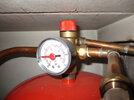- Joined
- 28 Nov 2023
- Messages
- 24
- Reaction score
- 0
- Country

I just checked while cooking supper. There's a stopcock under the kitchen sink. one inlet and a 3 branched outlet. One branch goes to the kichen cold water tap. and the other two disappear under the kitchen tiles to God knows where. From the discussion so far I'm assuming that one of the two disappearing branches goes to the EV, and the other to the loft storage tank.Normally under the sink?

